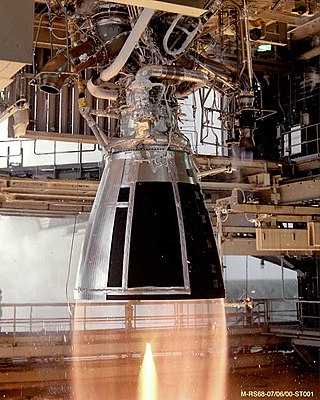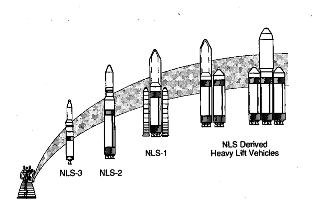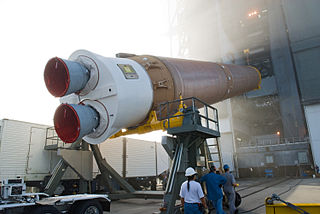
Delta II was an expendable launch system, originally designed and built by McDonnell Douglas, and sometimes known as the Thorad Delta 1. Delta II was part of the Delta rocket family, derived directly from the Delta 3000, and entered service in 1989. There were two main variants, the Delta 6000 and Delta 7000, with the latter also having "Light" and "Heavy" subvariants. During its career, Delta II flew several notable payloads, including 24 Global Positioning System (GPS) Block II satellites, several dozen NASA payloads, and 60 Iridium communication satellites. The rocket flew its final mission, ICESat-2, on 15 September 2018, earning the launch vehicle a streak of 100 successful missions in a row, with the last failure being GPS IIR-1 in 1997. In the late 1990s, Delta II was developed further into the unsuccessful Delta III, which was in turn developed into the more capable and successful Delta IV, though the latter shares little heritage with the original Thor and Delta rockets.

The Delta rocket family was a versatile range of American rocket-powered expendable launch systems that provided space launch capability in the United States from 1960 to 2024. Japan also launched license-built derivatives from 1975 to 1992. More than 300 Delta rockets were launched with a 95% success rate. The series was phased out in favor of the Vulcan Centaur, with the Delta IV Heavy rocket's last launch occurring on April 9, 2024.

Delta IV was a group of five expendable launch systems in the Delta rocket family. It flew 45 missions from 2002 to 2024. Originally designed by Boeing's Defense, Space and Security division for the Evolved Expendable Launch Vehicle (EELV) program, the Delta IV became a United Launch Alliance (ULA) product in 2006. The Delta IV was primarily a launch vehicle for United States Air Force (USAF) military payloads, but was also used to launch a number of United States government non-military payloads and a single commercial satellite.

National Security Space Launch (NSSL) is a program of the United States Space Force (USSF) intended to assure access to space for United States Department of Defense and other United States government payloads. The program is managed by the Assured Access to Space Directorate (SSC/AA) of the Space Force's Space Systems Command (SSC), in partnership with the National Reconnaissance Office.

The RS-68 (Rocket System-68) was a liquid-fuel rocket engine that used liquid hydrogen (LH2) and liquid oxygen (LOX) as propellants in a gas-generator cycle. It was the largest hydrogen-fueled rocket engine ever flown.

Atlas V is an expendable launch system and the fifth major version in the Atlas launch vehicle family. It was designed by Lockheed Martin and has been operated by United Launch Alliance (ULA) since 2006. It is used for DoD, NASA, and commercial payloads. It is America's longest-serving active rocket. After 87 launches, in August 2021 ULA announced that Atlas V would be retired, and all 29 remaining launches had been sold. As of June 2024, 16 launches remain. Production ceased in 2024. Other future ULA launches will use the Vulcan Centaur rocket.

Shuttle-derived vehicles (SDV) are space launch vehicles and spacecraft that use components, technology, and infrastructure originally developed for the Space Shuttle program.

The Exploration Systems Architecture Study (ESAS) is the official title of a large-scale, system level study released by the National Aeronautics and Space Administration (NASA) in November 2005 of his goal of returning astronauts to the Moon and eventually Mars—known as the Vision for Space Exploration. The Constellation Program was cancelled in 2010 by the Obama Administration and replaced with the Space Launch System, later renamed as the Artemis Program in 2017 under the Trump Administration.

United Launch Alliance, LLC (ULA) is an American launch service provider formed in December 2006 as a joint venture between Lockheed Martin Space and Boeing Defense, Space & Security. The company designs, assembles, sells and launches rockets, but the company subcontracts out the production of rocket engines and solid rocket boosters.

A modular rocket is a kind of multistage rocket which has components that can interchanged for different missions. Several such rockets use similar concepts such as unified modules to minimize expenses on manufacturing, transportation and for optimization of support infrastructure for flight preparations.

The Ares V was the planned cargo launch component of the cancelled NASA Constellation program, which was to have replaced the Space Shuttle after its retirement in 2011. Ares V was also planned to carry supplies for a human presence on Mars. Ares V and the smaller Ares I were named after Ares, the Greek god of war.

Ares I was the crew launch vehicle that was being developed by NASA as part of the Constellation program. The name "Ares" refers to the Greek deity Ares, who is identified with the Roman god Mars. Ares I was originally known as the "Crew Launch Vehicle" (CLV).

Atlas is a family of US missiles and space launch vehicles that originated with the SM-65 Atlas. The Atlas intercontinental ballistic missile (ICBM) program was initiated in the late 1950s under the Convair Division of General Dynamics. Atlas was a liquid propellant rocket burning RP-1 kerosene fuel with liquid oxygen in three engines configured in an unusual "stage-and-a-half" or "parallel staging" design: two outboard booster engines were jettisoned along with supporting structures during ascent, while the center sustainer engine, propellant tanks and other structural elements remained connected through propellant depletion and engine shutdown.

The Saturn C-3 was the third rocket in the Saturn C series studied from 1959 to 1962. The design was for a three-stage launch vehicle that could launch 45,000 kilograms (99,000 lb) to low Earth orbit and send 18,000 kilograms (40,000 lb) to the Moon via trans-lunar injection.

The Delta IV Heavy was an expendable heavy-lift launch vehicle, the largest type of the Delta IV family. It was the world's third highest-capacity launch vehicle in operation at the time of its retirement in 2024, behind NASA's Space Launch System and SpaceX's Falcon Heavy and closely followed by CASC's Long March 5. It was manufactured by United Launch Alliance (ULA) and was first launched in 2004. ULA retired the Delta IV Heavy in 2024. Future ULA launches will use the new Vulcan Centaur rocket. Delta IV's final flight was on 9 April 2024.

The National Launch System was a study authorized in 1991 by President George H. W. Bush to outline alternatives to the Space Shuttle for access to Earth orbit. Shortly thereafter, NASA asked Lockheed Missiles and Space, McDonnell Douglas, and TRW to perform a ten-month study.

The Common Core Booster (CCB) is a rocket stage, which is used as the first stage of the American Atlas V rocket as part of its modular design. It was also intended that two additional CCBs would be used as boosters on the Atlas V Heavy, however this configuration has not been developed. Use of a Common Core Booster as the first stage of the Japanese GX was also planned; however, this program was cancelled in late 2009.

The Delta Cryogenic Second Stage (DCSS) is a family of cryogenic-fuelled rocket stages used on the Delta III, Delta IV, and on the Space Launch System Block 1 launch vehicles. The DCSS employs a unique two-tank architecture where the cylindrical liquid hydrogen (LH2) tank carries payload launch loads and forms the upper section. An oblate spheroid tank filled with liquid oxygen (LOX) and the engine are suspended from the LH2 tank and covered by the interstage during initial launch.

The Space Launch System (SLS) is an American super heavy-lift expendable launch vehicle used by NASA. As the primary launch vehicle of the Artemis Moon landing program, SLS is designed to launch the crewed Orion spacecraft on a trans-lunar trajectory. The first SLS launch was the uncrewed Artemis 1, which took place on 16 November 2022.

Vulcan Centaur is a heavy-lift launch vehicle created and operated by United Launch Alliance (ULA). It is a two-stage-to-orbit launch vehicle consisting of the Vulcan first stage and the Centaur second stage. It replaces ULA's Atlas V and Delta IV rockets. It is principally designed for the National Security Space Launch (NSSL) program, which launches satellites for U.S. intelligence agencies and the Defense Department, but will also be used for commercial launches.





















